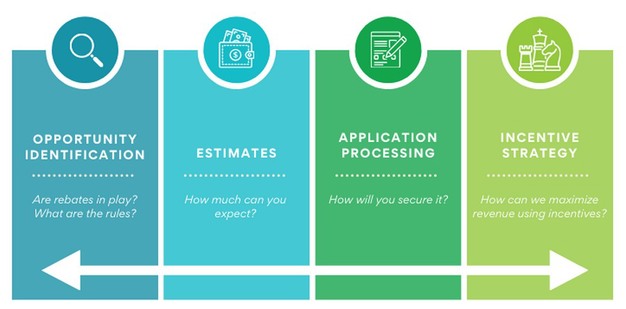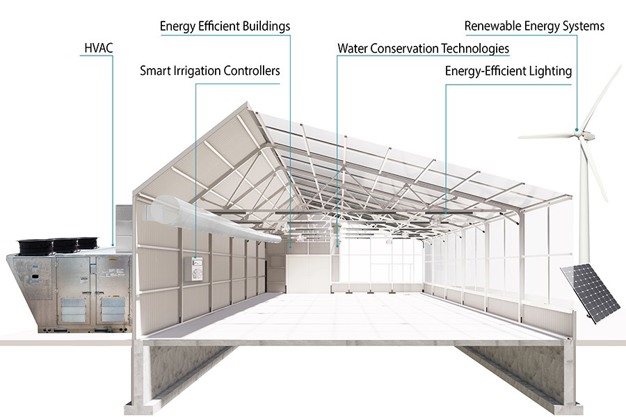"Strategic businesses build greenhouses to pay for them quickly. An effective way to lower the construction costs of greenhouse operations to ensure profitability and quick paybacks on capital investments is utility rebates for energy-efficient systems," Ceres Greenhouse Solutions says.
Growers across North America can reduce greenhouse buildout costs by applying for new construction rebates from energy efficiency programs, the team explains. "In U.S. states and Canadian provinces, utilities deliver financial incentives to commercial businesses to help their customers save energy."
"Businesses can apply for new construction incentives to offset the first costs of high-performance greenhouse systems like LED horticultural lighting, efficient HVAC equipment, environmental controls, infrared film, automated environmental controls, and energy curtains." Ceres Greenhouse Solutions claims that it uses efficient systems across the board, which means its designs qualify for the biggest rebates.
"Growers can maximize rebates by working with energy experts like the engineers at Energy Resources Integration (ERI) who help Ceres Greenhouse Solutions customers navigate rebate programs. ERI's engineers help growers understand eligibility requirements, identify programs, apply for as many rebates as possible, and get the most funding possible from their electric and gas utilities. ERI has helped hundreds of growers across the country access rebates with ease. While some programs are easy to navigate, others are more complex," the team says.
In California, ERI helped a cannabis cultivator receive $200,000 for their new high-performance greenhouse. "Systems receiving incentives included insulated greenhouse materials, LED horticultural lighting, and advanced lighting controls systems."
Some incentives may be at the whole-building level and involve a custom energy model for your greenhouse. "In certain regions, utility customers can get technical assistance with energy modeling of efficient new construction projects."
There are easy steps that ERI follows as they guide growers through the rebate process. "First, engineers find out if your greenhouse is located in a place with energy efficiency programs offering rebates for new construction or for efficient greenhouse equipment. Then, ERI evaluates your greenhouse design from Ceres Greenhouse Solutions to understand what systems are eligible and qualify for rebates. Energy calculations are performed to estimate how much you might receive for a given set of systems."
Rebates vary widely by location. "Some utilities offer incentives of $0.05/kWh while others offer much more, like $0.18/kWh. Once you decide to go for the rebate, ERI applies on your behalf and works with the utility's technical reviewers to defend the energy savings estimate and ensure you receive the largest incentive for your project. As you build out more greenhouses, ERI can offer recommendations for how incentives can improve the profitability of your operation through continuous improvement projects," Ceres says.
"As mentioned, Ceres' energy-efficient greenhouse solutions ensure growers a jumpstart on available rebates and incentives." Some systems or elements of a Ceres greenhouse that may qualify for rebates include among others:
Energy-efficient heating and cooling systems. Ceres EcoPack HVAC(D) uses heat pump technology to heat, cool, and dehumidify greenhouses and helps growers qualify for rebates aimed at promoting energy conservation.
In addition, they include renewable energy systems: Installing renewable energy systems such as solar panels or wind turbines to power your greenhouse operations could make you eligible for various incentives.
Moreover, Ceres SunSense controller helps to optimize greenhouse conditions such as temperature, humidity, and lighting and can contribute to energy savings by improving the efficiency of heating, cooling, lighting, and irrigation systems.'
Upgrading to energy-efficient lighting systems such as LED grow lights could make you also eligible for incentives aimed at reducing energy consumption. The same goes for energy-efficient buildings. Ceres' greenhouses are designed with insulated metal panel walls (IMPs), and align with passive-solar design concepts, meaning that the building envelope alone is energy-efficient and can qualify buyers for whole-building rebates.
Further, Ceres can integrate water-saving technologies like drip irrigation systems, rainwater harvesting systems, or water recycling systems that may qualify growers for incentives aimed at promoting sustainable water use.
"At Ceres, we are proud to partner with ERI and dedicated energy engineers such as Gretchen Schimelpfenig to enhance the savings of our greenhouse designs. Don't let steep upfront costs dampen your aspirations for an energy-efficient greenhouse operation; together, Ceres and ERI are here to unlock potential savings through rebate and incentive programs, transforming growers' visions into reality sooner than you might think," the team adds.
For more information:
Ceres Greenhouse Solutions
info@ceresgs.com
www.cerescann.com
